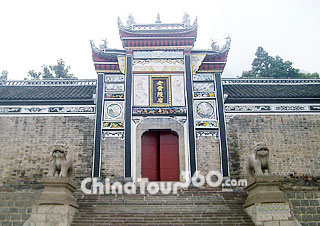 Huangling Temple, Xiling Gorge
Huangling Temple, Xiling Gorge
Huangling Temple is believed to be first constructed during the Spring and Autumn Period (770BC - 476BC). During the Three Kingdoms Period (220 - 280), Zhuge Liang decided on its reconstruction when he passed by the Yellow Ox Gorge and found it in disrepair. He then wrote the Yellow Ox Temple ariticle, which was engraved on a stone tablet in the temple. In 847 during the Tang Dynasty (618 - 907), it was reconstructed and named Yellow Ox Temple (Huang Niu Ci). However, later in the Song Dynasty (960 - 1279) when the famous writer Ouyang Xiu was the local county leader, he renamed it Huangling Temple for he did not believe the legend of the yellow ox. Today’s Huangling Temple was rebuilt during the Ming (1368 - 1644) and Qing (1644 - 1911) dynasties and was renovated several times in recent years.
Legend has it that the temple was built mainly to commemorate the yellow ox that helped to dredge the Yellow Ox Gorge and release floods. It was built on the Yellow Ox Mountain and named it Yellow Ox Temple (Huang Niu Miao). It was then renamed Huangling Temple during the Song Dynasty. The temple is an ancient architectural complex that includes the Mountain Gate (Shan Men), Hall of King Yu (Yu Wang Dian), Hall of Quyuan (Qu Yuan Dian), and the Hall of Buddha (Zu Shi Dian). Many precious hydrologic sites and data about the Yangtze River are kept in the temple. Hence, it becomes a hydrologic data bank recording the water-level fluctuations of the Yangtze River.
The first building at Huangling Temple is the Mountain Gate. The gate was often attacked by severe floods and was finally destroyed in 1870. In 1886, it was rebuilt with wood and bricks.
The Hall of King Yu, which is the main building of the temple, lies beyond the gate. It is on a platform 19 meters (62 feet) higher than the Mountain Gate and was reconstructed in the Ming Dynasty but renovated several times in the Qing Dynasty. Hence, it retains the architectural style of the late Ming Dynasty. In the center of the hall stands a 4-meter (4.4 feet) high statue of King Yu (Yu the Great) who regulated the floods in ancient China. There are also many columns in the hall and there are water marks left by the floods from the past 120 years on one of them.
On the platform 27-meter (88.6 feet) higher than the Hall of King Yu was the Hall of Qu Yuan, and 15 meters higher than Hall of Qu Yuan was the Hall of Buddha. However, the two halls were destroyed during the sino-Japanese war. Nevertheless, the four halls standing on the central axis comprise the major part of Huangling Temple.
Wuhou Temple was built beside the Hall of King Yu to commemorate Zhuge Liang for his contribution to the temple. Taking up an area of 160 square meters (191 square yards), the hall is decorated with statues and murals of Zhuge Liang.








